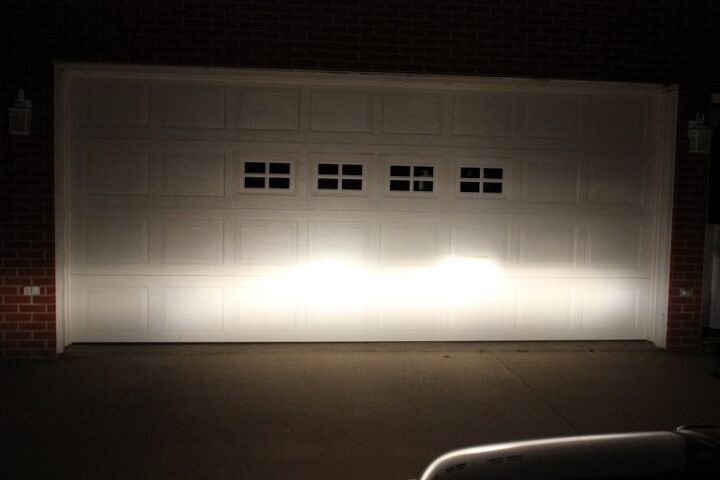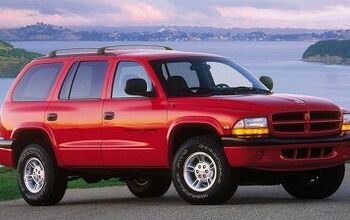Piston Slap: A Stern Talkin' to About OEM Headlamps (Part II)

I thought I would give everyone an update on the lighting situation on the Durango. After considering the advice from both you and Mr. Stern, I decided that after all the expense of the new OEM lights, the better bulbs and the relay harness, I would just go with the more labor-intensive lights and less labor-intensive wiring from The Retrofit Source. I ended up spending a little over my budget but the lights are worlds better. They’re also an engineered solution that doesn’t blind other drivers.
I made an album with several pictures, before and after, with different settings. As you can see, on the new set there is a distinct cutoff on the “dims.” The low beams are currently adjusted a bit low and I haven’t taken the time to fix that yet, but on the road it is a major improvement. Other than a confused look from my wife when I had to bake the headlight buckets to remove the lenses and finding a place for the computer, ballast, and relay, it wasn’t too bad.
It was a little more work than I had planned, but the all-in price wasn’t much more than going the OEM route. It is a very significant improvement. I did get to adjust them a bit, and then followed my brother-in-law to see if they were blinding everyone. He said it was no different than other traffic, so I think I will leave the alignment right there. The beans line up on the door with the dims slightly higher than the other lights, but the old lights were sort of a blob on the top and I used a guess as to where the “cut” line was.
Thanks for all the help. I wanted to do it right and have them be able to align correctly. Even though I didn’t follow your exact advice, you gave me the push in the right direction. It still isn’t a bad looking truck for 190k miles!
Sajeev responds:
I can’t say I agree with your decision…but I’ve seen much worse. Like mega-glaring aftermarket LED headlights with a non-existent cut line, lighting every rooftop (in urban areas) as they drive by.
My criticism of your retrofit is simple: 99.9% of the population can’t engineer a lighting solution with aftermarket bits never intended to fit behind your Durango’s lenses. From the photos I didn’t add (i.e. license plate), it seems you live in a more rural area, so that massively thick new hot spot certainly keeps you illuminated on a dark road in bad weather.
And the odds of anyone being bothered by that low-beam cut off is low. But is this retrofit in the spirit AND the letter of the law (so to speak)?
The candlepower forums’ moderator brought up valid concerns in this thread. And since I got it last time, let’s bring in the wisest man on this subject, Mr. Daniel Stern to wrap this up.
Daniel Stern concludes:
Often, what we feel like we’re seeing isn’t what we’re actually seeing. The human visual system is a lousy judge of how well it’s doing. “I know what I can see!” seems reasonable, but it doesn’t square up with reality because we humans are just not well equipped to accurately evaluate how well or poorly we can see (or how well a headlamp works).
Our subjective impressions tend to be very far out of line with objective, real measurements of how well we can — or can’t — see. The primary factor that drives subjective ratings of headlamps is foreground light, which is light on the road surface close to the vehicle… and which is almost irrelevant. It barely even makes it onto the bottom of the list of factors that determine a headlamp’s actual safety performance. A moderate amount of foreground light is necessary so we can use our peripheral vision to keep track of the lane lines and keep our focus up the road where it should be, but too much foreground light works against us: it draws our gaze downward even if we consciously try to keep looking far ahead, and the bright pool of light causes our pupils to constrict, which destroys our distance vision. All of this while creating the feeling that we’ve got good lights. It’s not because we’re lying to ourselves or fooling ourselves or anything like that, it’s because our visual systems just don’t work the way we feel that they work.
For that reason, the world’s headlamp technical standards and regulations for headlamps control foreground light as a proportion of the maximum intensity in the beam (the distance-vision “hot spot”). Many untested or fraudulently tested headlamps and components — at any price point — produce way too much foreground light: a strong wash of light close to the vehicle, but no (or not enough) concentrated hot spot to throw light down the road where you need it, so you get severely deficient seeing distance unless you aim the lamps up in the air… and then they blind everyone on the road, some of whom will write you tickets for it. Tip them down so you’re not glaring anyone, which you’re judging by the cutoff falling below other cars’ rearview mirrors? OK, but now the foreground’s even brighter while your seeing distance is sharply geometrically limited. Let’s do some math!
Regardless of the amount and distribution of light within the beam, by trigonometry the cutoff of a low beam mounted at a typical 2 feet above the road surface will intersect the road surface at:
282 feet ahead if aimed 0.7 percent down (the nominal U.S. spec)
We can readily calculate our maximum safe speed if an obstacle appears at the end of our seeing range, assuming a realistic coefficient of kinetic friction of 0.6 between (decent) tires and (dry) road, and including the well accepted 2-second recognition and reaction time of a fully alert driver:
17 mph with lamps aimed 2.75 percent down
What does this mean? Well, look at those low safe speeds even with lamps aimed at nominal specs. This is why so many of us gripe about our low beams not being adequate: they’re not! Their reach is limited by geometry, no matter the brightness. Most of us “overdrive” our low beams on a regular basis: we drive at speeds that require a longer view than our low beams can possibly give us. And remember, those figures are for a fully alert driver primed to encounter an obstacle at any moment. Most of us don’t maintain that kind of hypervigilance when we’re driving, so our reaction time is longer and our safe speeds are even lower.
The implications of all this:
Lamp aim is by far the main thing that determines how well you can (or can’t) see at night — it’s far more important than what kind of bulbs your headlamps have, whether they’re projector or reflector, European or U.S. type, etc — so see to it that the lamps are aimed carefully and correctly, not just by guess and by gosh.
By all means optimize your headlamps, but take the time to learn and understand what is and isn’t actually optimal.
Our eyes don’t inform us accurately how well our headlamps work, so most internet “reviews” are useless — and that would be the case even if we ignore the bogus criteria people often use when “reviewing” headlamps: sharp cutoff on low beam (very low on the list of factors that determine a headlamp’s actual safety performance, but it looks nifty on the garage wall), “E-code” (irrelevant; both the U.S. and the UN/”E-code” headlamp standards have lots of room for a huge range of headlamp performance), “high color temperature” (irrelevant at best)…and so on.
[Images: flipper35]
Old Headlights 2
Old Headlights 3
Old Headlights 4
Old Headlights 5
Old Headlights 6
New Headlights 1
New Headlights 2
New Headlights 3
New Headlights 4
New Headlights 5

More by Sajeev Mehta
Latest Car Reviews
Read moreLatest Product Reviews
Read moreRecent Comments
- SCE to AUX Figure 160 miles EPA if it came here, minus the usual deductions.It would be a dud in the US market.
- Analoggrotto EV9 sales are rivalling the Grand Highlander's and this is a super high eATP vehicle with awesome MSRPs. Toyota will need to do more than compete with a brand who has major equity and support from the automotive journalism community. The 3 row game belongs to HMC with the Telluride commanding major marketshare leaps this year even in it's 5th hallowed year of ultra competitive sales.
- Analoggrotto Probably drives better than Cprescott
- Doug brockman I havent tried the Honda but my 2023 RAV4 is great. I had a model 20 years ago which. Was way too little
- Master Baiter The picture is of a hydrogen fuel cell vehicle.












































Comments
Join the conversation
I have given up flashing my high beams at these idiots. When driving down 295 its amazing how many imbeciles "took the plunge" and "upgraded" to the blue OMG my chic digs em headlights.
When performed properly, I'm a huge proponent of HID/LED upgrades. I can't stand PnP HID/LED kits simply for the dazzle factor. The ricer/ghetto blue headlight color temp actually REDUCES vision. Not only do the bulbs generally require a blue filter to produce that high-kelvin color (which reduces light output), blue is the harshest color for our eyes to process, and the extra blue glare makes it 10x harder on other drivers. I personally don't care if someone retrofits their headlamps, but please do it properly! Purely anecdotal, take the Mk4 Jetta (Bora)/Golf. While their halogen lights are worlds better than the terrible DOT only domestic setups of the time, they still leave a lot to be desired. When replaced with a proper HID bi-xenon projector and properly aligned, even the pitch black rural roads on which I used to live became better. Personally, I prefer a slightly higher color temperature. Sure, you get a bit more light from 4300k, but 5000-5500k is easier on my eyes. UNlike some, I also don't like a super-sharp cutoff. Using a fresnel lens instead of a clear lens gives a more diffuse cutoff which I find to be easier on my eyes, too. Sure, you lose the hella cool wall shot and the pretty color flicker, but I don't care about that. OEM headlamp efficacy has definitely improved in recent years, but they still frequently leave a lot of performance on the table because most OEMs are concerned with meeting standards at a low price and not outright performance.